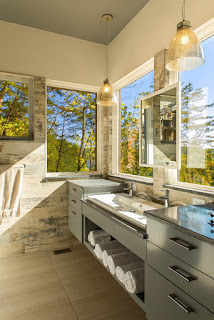Today’s major trend in home building and
remodeling are home designs that connect the outdoors with the indoor. These
new wide-span doors from Marvin, Andersen, and others, create expansive
openings, while engineered to slide easily and make a perfect seamless
connection between the indoors and outdoors. A traditional slider can be up to
10 foot wide, while these doors can be up to 16 feet wide. The design
significantly opens the view and allows for natural ventilation into your home.
 |
| Marvin Integrity Sliding Doors |
These beautifully designed and engineered
doors can take a big bite out of your budget. Before you rule out creating
oversized openings between your home and the outside, consider other
alternatives that will give you essentially the same result for a smaller
investment.
Creating oversized door openings and
expansive window walls can be achieved on a budget by using standard sized
windows and doors put together in a modular way to achieve the look you want.
Depending on the overall size you need, your options for creating the look you
want are limitless.
Sliding
patio doors have evolved and can now be selected in one-two-or three
panel doors, up to eight feet tall, creating a wide opening. Add sidelights or
a transom to expand your views even more. You can also use multiple sliding
doors side by side to open the space even wider. Sliding patio doors can be
very versatile system if designed where immense areas of glass are desirable.
French
doors are a classic favorite that adds architectural detail to any space.
Although these hinged doors require less wall space than sliding doors, if they
are in-swing doors you’ll need to plan your furniture arrangement to
accommodate them. The pair of doors are typically about six feet wide, although
you can pair the doors with sidelights and even place two sets of French doors
side by side to fill an entire wall.
 |
| Andersen 100 Series Sliding Doors |
The
French slider has the appearance of a classic French door with wider
stiles and rails, while functioning as a sliding glass door. It’s a nice hybrid
between the sliding patio door and the French hinged door. Typically, French
sliders have four panels, two of which remain stationary. When closed, the
center panels look like a pair of French doors – a classically beautiful look.
Sidelights,
Transoms and Awnings can be mixed and matched with sliding, French doors, or
French sliders to create an expansive opening. Traditionally, sidelights were
narrow picture windows, which were more decorative than functional. Transoms
over interior and exterior doors adorned old homes. Awnings were used, prior to
air conditioning to ventilate a home. In the 1950’s when ceilings were lowered
these functional windows largely disappeared from home designs. Today, these
styles are making a comeback to ventilate spaces, as modern homes are built
with higher ceilings, large glass windows and glass doors.
 |
| Andersen French Doors |
The new expansive doors that connect the
outdoors with the indoor are magnificent – lift and slides create an uninterrupted
wall of glass – spanning 16 feet tall, which disappears into a wall. Folding glass doors achieve a similar look but don’t require pockets in an adjacent
wall. Or Pivot doors that swing open to a perfect 90º are all the rage because
of their architectural beauty. Now you can create the same look on your budget
with a little imagination.
Marvin, Andersen, Pella and other Woodlandselected window and door manufacturers offer unlimited choices to create
oversized openings – you dream and we’ll help you put the components together
to bring the outside in.




